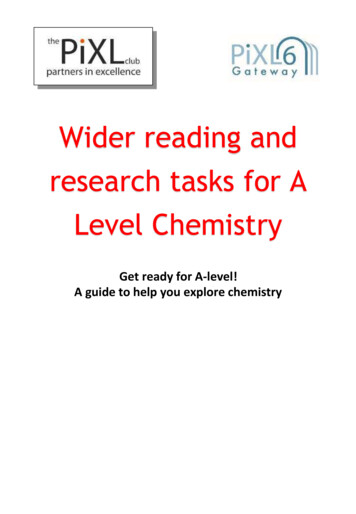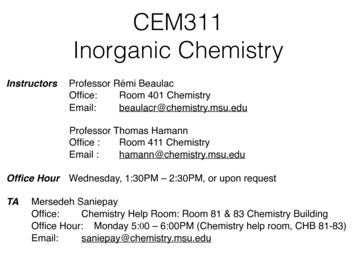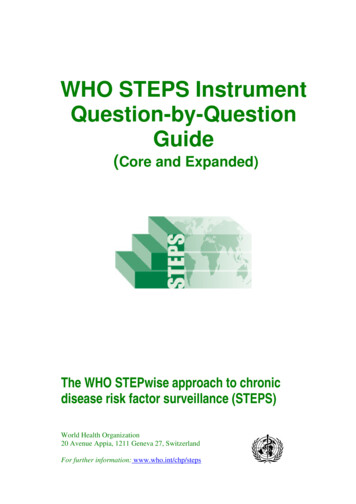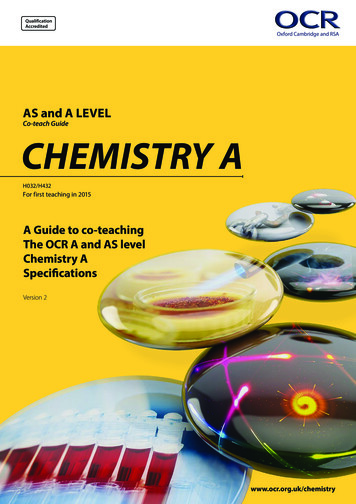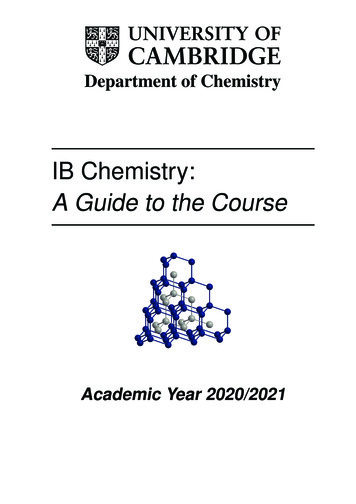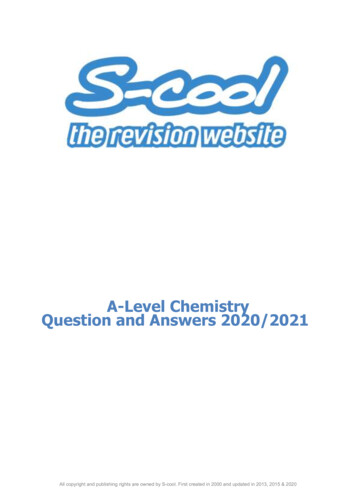
Transcription
A-Level ChemistryQuestion and Answers 2020/2021All copyright and publishing rights are owned by S-cool. First created in 2000 and updated in 2013, 2015 & 2020
Table of ContentsTopics that only contain interactive questions . 3Atomic Structure (Questions) * . 4Atomic Structure (Answers) . 6Atoms, Molecules and Stoichiometry (Questions) . 8Atoms, Molecules and Stoichiometry (Answers) . 9Chemical Equilibria (Questions) . 11Chemical Equilibria (Answers) . 12Electrochemistry (Questions) * . 13Electrochemistry (Answers). 14Group II and Group IV (Questions) * . 15Group II and Group IV (Answers) . 16Group VII (Questions). 18Group VII (Answers) . 19Ionic Equilibria (Questions) . 20Ionic Equilibria (Answers). 22Reaction Kinetics (Questions) . 24Reaction Kinetics (Answers). 25States of Matter (Questions) . 26States of Matter (Answers) . 27* topics that contain interactive resources, multiple choice questions or audio files. To interactwith this content, please go to www.s-cool.co.uk/a-level/chemistry.These questions cover the main areas of this subject. Please check the specific areas you need withyour exam board. They are provided “as is” and S-cool do not guaranteed the suitability, accuracy orcompleteness of this content and S-cool will not be liable for any losses you may incur as a result ofyour use or non-use of this content. By using these notes, you are accepting the standard terms andconditions of S-cool, as stated in the s-cool website (www.s-cool.co.uk).2All copyright and publishing rights are owned by S-cool. First created in 2000 and updated in 2013, 2015 & 2020
Topics that only contain interactive questionsThese topics only contain interactive questions such as animations, multiple choice or audio files. Tointeract with this content, please go to www.s-cool.co.uk/biology. Aliphatic CompoundsAromatic and PlasticsChemical EnergeticsGeneral PrinciplesIonic EquilibriaPeriodicityTransition Metals3All copyright and publishing rights are owned by S-cool. First created in 2000 and updated in 2013, 2015 & 2020
Atomic Structure (Questions) *1. Chemists use a model of an atom that consists of three types of sub-atomic particle. These are protons,neutrons and electrons.a) Complete the table below, which shows the properties of these particles.Particle Relative Charge Relative MassElectronProton1Neutron 0(4 marks)b) Types of atoms and ions vary from each other by the number of sub-atomicparticle found in them. What differences are there between12C and14C?(1 mark)c) Define the term 'isotope'.(1 mark)d) Write down the electronic configuration of Cr3 .(1 mark)(Marks available: 7)2.a) The first ionisation energy for lithium is 519 kJmol-1.Write an equation to show what is meant by this statement.(1 mark)4All copyright and publishing rights are owned by S-cool. First created in 2000 and updated in 2013, 2015 & 2020
b) The second ionisation energy for lithium is 7300 kJmol-1.Explain the difference in value for the first and second ionisation energy forlithium.(1 mark)(Marks available: 2)5All copyright and publishing rights are owned by S-cool. First created in 2000 and updated in 2013, 2015 & 2020
Atomic Structure (Answers)Answer outline and marking scheme for question: 1a)ParticleRelative ChargeRelative MassElectron-11/1820 or negligibleProton 11Neutron01(4 marks)b) 12C has 6 protons, 6 neutrons and 6 electrons.14Chas 6 protons, 6 electrons and 8 neutrons. The difference between this pairis that14C has two more neutrons than12C.(1 mark)c) An isotope of an element has the same number of protons but a differentnumber of neutrons.(1 mark)d) 1s2 2s2 2p6 3s2 3p63d3 4s0(1 mark)(Marks available: 7)6All copyright and publishing rights are owned by S-cool. First created in 2000 and updated in 2013, 2015 & 2020
Answer outline and marking scheme for question: 2a) Li(g) - e- Li (g)The electronic configuration of lithium is 1s2 2s1. Itis relatively easy to remove the electron from the 2s orbital as it is shieldedfrom the nuclear charge by the 1s electrons.(1 mark)b) To remove the second electron for the second ionisation energy requiresconsiderably more energy as this electron comes from the 1s shell which is closerto the nucleus and not subject to any shielding.(1 mark)(Marks available: 2)7All copyright and publishing rights are owned by S-cool. First created in 2000 and updated in 2013, 2015 & 2020
Atoms, Molecules and Stoichiometry (Questions)1.Calculate the mean relative atomic mass of nickel from the mass spectrum.(Marks available: 2)2. In 1774 Joseph Priestly conducted one of his most famous experiments whichlead to a method for the preparation of oxygen. The experiment involved heatinga sample of mercury II oxide with a large lens.The equation for this reaction is shown below:2HgO(s) 2Hg(l) O2(g)a) What volume of O2(g) would be obtained if 1.08g of mercuryII oxide were completely decomposed? (Given that 1 mole of a gas occupies 24dm3 under the experimental conditions)(Marks available: 3)3. An organic compound is found to have the following composition by mass:C 72.7%; H 6.1%; N 21.2%.a) Calculate the empirical formula of the compound.(2 marks)b) The molar mass of the compound is 198 gmol-1. Calculatethe molecular formula of the compound.(3 marks)(Marks available: 5)8All copyright and publishing rights are owned by S-cool. First created in 2000 and updated in 2013, 2015 & 2020
Atoms, Molecules and Stoichiometry (Answers)Answer outline and marking scheme for question: 1Intensities of peaks:58Ni 10.2 69.4% of total (abundance)59Ni 3.9 26.5% of total (abundance)62Ni 0.6 4.1% of total (abundance)(Sum of intensities 14.7)Mean relative atomic mass (58 x 69.4) (59 x 26.5) (62 x 4.1) 58.4100(Marks available: 2)Answer outline and marking scheme for question: 2Molar mass of HgO 201 16 217 gmol-11.08g of HgO will contain 1.08 / 217 mols 0.005molFrom the equation, 1 mole of O2(g) is produced from 2 moles of HgOThis means that 0.005 mol of HgO will produce 0.005 / 2 mol of O2 0.0025 mol0.0025 mol of O2 will occupy 0.0025 x 24dm3 0.06dm3(Marks available: 3)9All copyright and publishing rights are owned by S-cool. First created in 2000 and updated in 2013, 2015 & 2020
Answer outline and marking scheme for question: 3Ratio of elements in compound C : H : NRatio C : N : H 72.7 / 12 : 6.1 / 1 : 21.2 / 14 6.1 : 6.1 : 1.5Whole number ratio 4 : 4 : 1Empirical formula of compound is C4H4N(Marks available: 5)10All copyright and publishing rights are owned by S-cool. First created in 2000 and updated in 2013, 2015 & 2020
Chemical Equilibria (Questions)1.Esters are a useful group of compounds due to their distinctive smells. One exampleof an ester is ethyl ethanoate, its formation is shown below.CH3COOH(aq) C2H5OH(aq)λCH3COO C2H5(aq) H2O(l)a) Systems like this are described as being a 'dynamic equilibrium'. Explainthe term 'dynamic equilibrium'b) Write down the expression for the equilibrium constant, Kc, for this reaction.c) Calculate the value of Kc for this reaction given the equilibrium concentrations below.[CH3COOH] 0.08 moldm-3[C2H5OH] 0.08 moldm-3[CH3COO C2H5] 0.25 moldm-3[H2O] 0.1 moldm-3d) Concentrated sulphuric acid is added to the reaction mixture as it removes water molecules. What effectwould this have on the equilibrium position of this system?(Marks available: 7)2. The Haber-Bosch process is used for the large-scale production of ammonia fromnitrogen and hydrogen gas. The reaction is shown below:N2(g) 3H2(g)λ2NH3(g)a) Write an expression for Kp for this reaction.b) What are the units of Kp for this reaction? (Assume pressure is measured in kPa)c) When the temperature is raised for this process the proportion of NH3(g) in the mixture decreases. Explain thisobservation.d) What effect will an increase in the total pressure have on the equilibrium position?(Marks available: 5)11All copyright and publishing rights are owned by S-cool. First created in 2000 and updated in 2013, 2015 & 2020
Chemical Equilibria (Answers)Answer outline and marking scheme for question: 1a)- concentrations of the species are constant- forward and backward reactions are continually taking place but at the same rate.b) Kc [CH3COO C2H5] [H2O][CH3COOH][C2H5OH]c) Kc [CH3COO C2H5] [H2O] (0.25) (0.1) 3.91 (no units)[CH3COOH] [C2H5OH](0.08)(0.08)(1 mark numerical answer, 1 mark stating no units)d) Concentrated sulphuric acid is added to the reaction mixture as it removes water molecules. What effectwould this have on the equilibrium position of this system?(Marks available: 7)Answer outline and marking scheme for question: 2a) Kp (p NH3)2 (1)(p N2)(pH2)2b) Units kPa2 1 / kPa2 kPa-2kPa x kPa3c) Increase in temperature leading to decrease in NH3 means reactiontowards right is exothermic.d) An increase in pressure will lead to an increase in the proportion of NH3(g) found in the mixture.12All copyright and publishing rights are owned by S-cool. First created in 2000 and updated in 2013, 2015 & 2020
(Marks available: 5)Electrochemistry (Questions) *1. Dichromate (VI) ions are powerful oxidising agents and are reduced to chromium III ions. This colour changewas once used in 'breath test' apparatus to determine if a driver had consumed excessive alcohol.Explain the term 'redox reaction'(Marks available: 1)2. Aluminium metal is extracted from molten bauxite (Al2O3.2H2O)using electrolysis. Cryolite (AlF3) added to the ore in order tolower the melting point required and thus the energy required by the process.a) Write a half equation to show how aluminium metal is produced fromthe ore.(1 mark)b) What mass of aluminium metal would be produced if a current of 30,000Ais applied to a cell for 1 hour?(4 marks)c) In the molten mixture there is a mixture of anions which mostly consistsof O2- and F-. Write an equation to show whichof these anions will be oxidised in the cell?(2 marks)(Marks available: 7)13All copyright and publishing rights are owned by S-cool. First created in 2000 and updated in 2013, 2015 & 2020
Electrochemistry (Answers)Answer outline and marking scheme for question: 1A redox reaction is one where electrons are transferred from one species to another.(Marks available: 1)Answer outline and marking scheme for question: 2a) Al3 (l) 3e- Al(l)(1 mark)b) Charge passed; E ItE 30,000 x 3600 1.08 x 108C (1)1 mole of electron has a charge of 96,500CMols electrons (1.08 x 108) / 96,500 1119 mols (1)To reduce 1 mol of Al3 , 3 mols of electrons are requiredIn the cell 1119 / 3 373 mols of Al produced (1)Ar Al 27.0Mass Al produced 373 x 27.0 10071g 10.071kg of Al (1)(4 marks)c) 2O2-(l) - 4e- O2(g)(1 for correct anion, 1 for correct equation)(2 marks)14All copyright and publishing rights are owned by S-cool. First created in 2000 and updated in 2013, 2015 & 2020
(Marks available: 7)Group II and Group IV (Questions) *1. Barium is a member of Group II of the periodic table.a) Write an equation to show the reaction of barium metal with water.(1 mark)b) Write an equation to show the thermal decompositionof barium nitrate(1 mark)c) Explain why magnesium sulphate is soluble in water but barium sulphateis not.(2 marks)(Marks available: 4)2.The following questions are about the members of Group IV of the periodic table.a) What type of bonding is seen in silicon tetrachloride, SiCl4,(1 mark)b) Write an equation to show the reaction of silicon tetrachloride,SiCl4, with water.(1 mark)c) Explain why silicon tetrachloride can react with water but carbontetrachloride does not.(2 marks)b) Explain why lead can form lead (II) chloride but silicon cannot formsilicon (II) chloride.(2 marks)(Marks available: 6)15All copyright and publishing rights are owned by S-cool. First created in 2000 and updated in 2013, 2015 & 2020
Group II and Group IV (Answers)Answer outline and marking scheme for question: 1a) Ba(s) 2H2O(aq) Ba(OH)2(aq) H2(g)(1 mark)b) 2Ba(NO3)2(s) 2BaO(s) 4NO2(g) O2(g)(1 mark)c) There are two factors that affect the solubility in water; latticeenergy and enthalpy of hydration.As both salts are sulphates, there is little difference in lattice enthalpy(1)The enthalpy of hydration is much higher for barium as it has a higher ionicradius (lower charge density) which makes it difficult for water to hydrate.(1) (less of an attraction between cation and polar water molecules)(2 marks)(Marks available: 4)Answer outline and marking scheme for question: 2a) Covalent(1 mark)b) SiCl4(l) 2H2O(l) SiO2(aq) 4HCl(g)(1 mark)c) The silicon has 3d electron orbitals available (1)Which can accept a lone pair of electrons from the oxygen atom of water. (1)Carbon does not have any d electron orbitals available.16All copyright and publishing rights are owned by S-cool. First created in 2000 and updated in 2013, 2015 & 2020
(2 marks)d) The 6s electrons in lead are drawn in to the nucleus of the atomdue to poor shielding by d and f orbital electrons. This means that they behavelike an 'inert pair' of inner electrons rather than an 'active pair' of outerelectrons. (1)Silicon does not have any d or f electron orbitals filled therefore the 3s electronorbitals become hybridised with the 3p electrons giving silicon a valency of4. (1)(2 marks)(Marks available: 6)17All copyright and publishing rights are owned by S-cool. First created in 2000 and updated in 2013, 2015 & 2020
Group VII (Questions)1. Astatine (As) is a member of Group VII of the periodic table.(You may consult a data book if necessary for this question)a) What is the colour and state of Astatine at room temperature?(2 marks)b) What is the oxidation number of As in NaAsO3?(1 mark)c) Write an equation to show the reaction between astatine and coldaqueous sodium hydroxide.(1 mark)d) Predict the bond energy of H-As bond.(1 mark)e) Chlorine gas is passed through an aqueous solution of potassium astatide,KAt. Write an equation to show what reaction will take place.(1 mark)f) Under certain conditions it is possible for the following reactionto take place:3AsO- 2As- AsO3What is the name given to this type of reaction?(1 mark)g) Give a method for testing for the presence of astatideions in aqueous solution.(2 marks)(Marks available: 9 marks)18All copyright and publishing rights are owned by S-cool. First created in 2000 and updated in 2013, 2015 & 2020
Group VII (Answers)Answer outline and marking scheme for question: 1a) Astatine will be a black(1) solid(1)(2 marks)b) Oxidation number 5(1 mark)c) Predict the bond energy of H-As bond.(1 mark)d) Bond energies / kJmol-1H-F 562H-Cl 431H-Br 366H-I 299H-As ?From pattern between H-Cl and H-I.: Bond energy of H-As 232 kJmol-1 (1)(1 mark)e) Cl2(g) 2As-(aq) As2(s) 2Cl-(aq)(1 mark)f) Disproportionation(1 mark)g) Add aqueous silver nitrate (1)Presence of astatide ions would be indicated by a dark yellow / orange precipitateof AgAs (1)(2 marks)19All copyright and publishing rights are owned by S-cool. First created in 2000 and updated in 2013, 2015 & 2020
(Marks available: 9)Ionic Equilibria (Questions)1. Benzoic acid, C6H5COOH is a weak acid. When dissolved in water the followingreaction takes place:C6H5COOH(aq) H2O(aq)λC6H5COO-(aq) H3O (aq)a) Explain what is meant by the term 'weak acid'.(1 mark)b) A solution is made of benzoic acid at 25 C. The acid dissociationconstant for benzoic acid is 6.3 x 10-5 moldm-3. Writedown an expression for Ka.(1 mark)c) Calculate the pH of a 0.005M solution of benzoic acid.(1 mark)(Marks available: 3)2. Calculate the pH of the following solutions.a) 0.1M HCl (aq).(2 marks)b) 0.1M Be(OH)2(aq)(2 marks)(Marks available: 4)3. Precipitation reactions are an important method of identifying the inorganicions in a solution.For example silver nitrate is used to identify halides in solution.a) Write down the expression for the solubility product, Ksp, for silverchloride, AgCl.20All copyright and publishing rights are owned by S-cool. First created in 2000 and updated in 2013, 2015 & 2020
(1 mark)b) Ksp for AgCl is 1.8 x 10-10 mol2dm-6. Calculatethe concentration of Ag (aq) in a saturated solution ofAgCl.(1 mark)c) What effect will the addition of HCl have on the solubility of AgCl?(2 marks)(Marks available: 4)21All copyright and publishing rights are owned by S-cool. First created in 2000 and updated in 2013, 2015 & 2020
Ionic Equilibria (Answers)Answer outline and marking scheme for question: 1a) A weak acid is one that does not completely dissociate when dissolvedin aqueous solution.(1 mark)b) Ka [C6H5COO-][ H3O ][C6H5COOH](1 mark)c) From equation we know that [C6H5COO-] [ H3O ]. We can replace these concentrations in theexpression of Ka with x2.Take [C6H5COOH] 0.005M (as degree of dissociationis small there will be a negligible effect on this concentration).Ka x2 / 0.005 6.3 x 10-5 (1)x2 0.005 x (6.3 x 10-5) 3.2 x 10-7x 5.7 x10-4 (1)[H ] 5.7 x 10-4 moldm-3pH -lg[H ]pH of solution -lg(5.7 x 10-4) 3.2(1 mark)(Marks available: 3)Answer outline and marking scheme for question: 2a) Acid is fully dissociated - [H ] 0.1 moldm-3pH -lg[H ]pH -lg[0.1] 122All copyright and publishing rights are owned by S-cool. First created in 2000 and updated in 2013, 2015 & 2020
(2 marks)b) Base is fully dissociated - [OH-] 2 x 0.1 0.2 moldm-3 pOH -lg[OH-] 0.7pH pOH 14pH 14 -0.7 13.3(2 marks)(Marks available: 4)Answer outline and marking scheme for question: 3a) Ksp [Ag (aq) ][Cl-(aq)](1 mark)b) From equation [Ag (aq) ] [Cl-(aq)]Ksp [Ag (aq) ]2 1.8 x 10-10[Ag (aq) ] 1.3 x 10-5 moldm-3(1 mark)c) Addition of HCl leads to an increase in [Cl-(aq)]This means that [Ag (aq) ][Cl-(aq)]is greater than KspAnd AgCl will precipitate from the solution i.e. solubility has decreased.(2 marks)(Marks available: 4)23All copyright and publishing rights are owned by S-cool. First created in 2000 and updated in 2013, 2015 & 2020
Reaction Kinetics (Questions)1. Nitrogen (II) oxide reacts with oxygen in the following way:2NO(g) O2(g) 2NO2(g)Experiments were carried out to determine the orders of reaction with respect to NO and O 2. The results of theseexperiments are shown below.Experiment [NO(g)] / moldm-3 [O2(g)] / moldm-3 Rate / moldm-3 s-111.5 x 10-50.5 x 10-52.1 x10-724.5 x 10-50.5 x 10-51.9 x10-631.5 x 10-52.0 x 10-58.4 x10-7a) Using the data, deduce the orders of reaction with respect to NO and O 2.b) Write down the rate equation for this reaction and use it to calculate k.c) Explain the meaning of the term 'rate determining step'?2. Carbon dating using14C is a highly important tool in archaeology. Using this technique it is possibleto determine the length of time since an organism has died. The half-life of14C is 5600 years.a) Define the term 'half-life'.b) A sample of wood taken from an archaeological dig is analysed and found to have a radioactive count of 4counts per minute per gram of carbon. A new sample of the same type of wood has a count of 16 c.p.m.g-1.What is the approximate age of the archaeological sample?c) Which order of kinetics does radioactive decay follow?(Marks available: 3)24All copyright and publishing rights are owned by S-cool. First created in 2000 and updated in 2013, 2015 & 2020
Reaction Kinetics (Answers)Answer outline and marking scheme for question: 1a) For NO - examine experiments 1 and 2. A 3-fold increase in the concentration of NO leads to a 9-fold increasein rate. (1)This means that the reaction must be second order with respect to NO. (1)For O2 - examine experiments 1 and 3. A 4-fold increase in O2 concentration leads to a 4-fold increase in rate.(1)This means that the reaction must be first order with respect to O2. (1)b) Rate k[NO]2[O2] (1)2.1 x10-7 k (1.5 x10-5)2 (0.5 x10-5)k (2.1 x10-7) / (1.5 x10-5)2 (0.5 x10-5)k 1.9 x 108 mol-2dm6s-2c) The rate-determining step is the slowest section of the mechanism of the reaction when compared with theother steps.Answer outline and marking scheme for question: 2a) The half-life of a substance is the time taken for its concentration to decrease by 50%.b) After 5600 years the count form the piece of new wood would drop to 8 c.p.m, after a further 5600 years itwill drop to 4 c.p.m.The old wood is therefore approximately two half-lives old 11200 years.c) First order(Marks available: 3)25All copyright and publishing rights are owned by S-cool. First created in 2000 and updated in 2013, 2015 & 2020
States of Matter (Questions)1. Hydrogen generated from the reaction between magnesium and nitric acid wascollected. At a temperature of 30 C and pressureof 1.2 x 105 Nm-2, 340cm3 of gaswas collected.What would the volume of this gas be at s.t.p.?(Marks available: 2)2. The ideal gas equation can be written as 'PV nRT'a) Use this equation to calculate the volume of 0.5 moles of an idealgas at 350K and 1x 105Nm-2 pressure.(2 marks)b) A compound was vaporised and it was found that 0.15g of the gas occupied120cm3 at 323K and 100 kPa.Calculate the molecular mass of the compound.(2 marks)(Marks available: 4)3. Explain in terms of structure and bonding:a) Why graphite conducts electricity but diamond does not.(3 marks)b) Why water is a liquid at room temperature but hydrogen sulphide isa gas.(2 marks)(Marks available: 5)26All copyright and publishing rights are owned by S-cool. First created in 2000 and updated in 2013, 2015 & 2020
States of Matter (Answers)Answer outline and marking scheme for question: 1Reaction conditions: P1 1.2 x 105 Nm-2 ; T1 303K ; V1 340cm3S.t.p.P2 1.01 x105 Nm-2 ; T2 273K (1)P1V1 P2V2 (1.2x 105)(340) (1.01 x105)V2T1 T2 303273V2 364.0 cm3(Marks available: 2)Answer outline and marking scheme for question: 2a) Rearranging the equation: V nRT/PV 0.5 (8.314)(350) / (1 x 105)V 0.015 m3 (numerical 1, units 1)(2 marks)b) Using PV nRT and n m / Mrn PV / RT (1 x 105)( 0.00012) / (8.314)(323)n 0.00427All copyright and publishing rights are owned by S-cool. First created in 2000 and updated in 2013, 2015 & 2020
Mr 0.15 / 0.004 37.5(2 marks)(Marks available: 4)Answer outline and marking scheme for question: 3a) The carbon atoms in graphite are covalently bonded to three othercarbon atoms and have delocalised electrons in between the sheets of atoms.(1 mark)These delocalised electrons are able to move when a p.d. is applied(1 mark)The carbons in diamond are covalently bonded to four other carbonatoms so there are no electrons able to move freely.(1 mark)(max 3 marks)b) Water (H2O) has a higher boiling point due to there beinga lot of hydrogen bonding between the molecules.Hydrogen sulphide (H2S) has a much lower boiling point because thereis a much lower degree of hydrogen bonding.(2 marks)(Marks available: 5)28All copyright and publishing rights are owned by S-cool. First created in 2000 and updated in 2013, 2015 & 2020
your exam board. They are provided "as is" and S-cool do not guaranteed the suitability, accuracy or completeness of this content and S-cool will not be liable for any losses you may incur as a result of your use or non-use of this content. By using these notes, you are accepting the standard terms and


